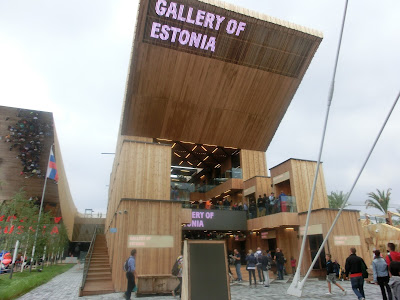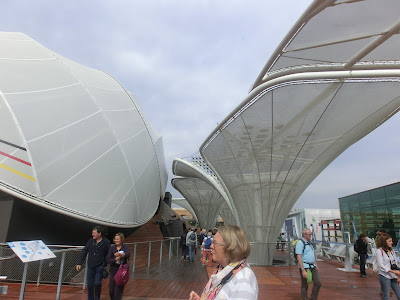
Austria is world-renowned as a country of culture, with a high standard of living. Austria’s key aim at the Expo Milano 2015 is to reinforce its reputation worldwide as an attractive place to live. Inside its 1,910 square meter exposition site, it showcases the naturally high standards and recreational spaces that make it so well-regarded.
Its positive image are enriched by new elements, such as the landscape and climate, playing a key role in drivingawareness around the use of sustainable resources.


The pavilion creates a small scale Austrian forest that provides 62.5 kilograms of fresh oxygen every hour, without filters or conditioners, which is enough for 1,800 people in an ideal climate, providing wellness and absorbing CO2. It is a green lung that induces the desire for a cleaner world, offering a model for urban practicesthat can ensure a higher quality of life and demonstrating the benefits of a reforestation policy against the global decline of green areas.


Azerbaijan is strategically located in Caucasia between the North, South, East and West, and is one of Mankind’s oldest cultural sites, a crossroads for history, culture, biology, nature and ecology.
The awareness of its strategic location, cultural bridge between North and South, East and West, has inspired policies to protect the territory of this country, rich in natural, human and cultural resources.
The Pavilion Project
The Simmetrico Network project presents a very simple and modern architecture achieved with traditional materials like wood and stone, which combine innovatively with metal and glass.
 The sides of the pavilion are created using highly flexible wood over an area measuring 887 square meters; the north side is more open to favor air ventilation and a micro climate. Its variety of spaces and forms looks to recreate an extensive climatic biodiversity and reflect cultural aspects of Azerbaijan.
The sides of the pavilion are created using highly flexible wood over an area measuring 887 square meters; the north side is more open to favor air ventilation and a micro climate. Its variety of spaces and forms looks to recreate an extensive climatic biodiversity and reflect cultural aspects of Azerbaijan.
Theme "Protection of Organic Food and Biodiversity for Future Generations"
Its individual interpretation of the theme of Expo Milano 2015: Feeding the Planet, Energy for Life is centered on thematic itineraries that aim to educate visitors on Azerbaijan as a great producer and exporter of organic, genuine and healthy products. It also seeks to promote the great historical and cultural traditions in the food industry and to introduce a new political vision focus on sustainable development, biodiversity and health for future generations.


 CHINA
CHINA Theme: "Land of Hope, Food for Life"

China’s theme captures an attitude of thankfulness, respect and cooperation that characterizes its people: the land has fed man from its beginnings and hope suggests the prospect of a future where food can offer life to everyone.
Agriculture, food, environment, sustainable development are the focal points of China's participation in Expo Milano 2015.
Its aim is to recall the tenet of Chinese philosophy that "man is part of nature," and to illustrate its cultural traditions and progress in the areas of agriculture, showcasing the great strides made in the use of resources for providing a sufficient supply of good and healthy food.

The exhibition area of 4,590 square meters unfolds around three themes. "The Gift of Nature" illustrates crop processes according to the Chinese lunisolar calendar and the five colors of the soil. "Food for Life" shows the production path of foods including tofu and other dishes, China’s famous eight schools of cuisine, and its tea culture. "Technology and the Future" charts the progress of science, including the hybrid rice of Professor Yuan Longping, recycling in agriculture and techniques for tracking the Internet of things.
Its aim is to recall the tenet of Chinese philosophy that "man is part of nature," and to illustrate its cultural traditions and progress in the areas of agriculture, showcasing the great strides made in the use of resources for providing a sufficient supply of good and healthy food.

The exhibition area of 4,590 square meters unfolds around three themes. "The Gift of Nature" illustrates crop processes according to the Chinese lunisolar calendar and the five colors of the soil. "Food for Life" shows the production path of foods including tofu and other dishes, China’s famous eight schools of cuisine, and its tea culture. "Technology and the Future" charts the progress of science, including the hybrid rice of Professor Yuan Longping, recycling in agriculture and techniques for tracking the Internet of things.
 This is the first time that China participates in a Universal Exposition with a self-built pavilion, symbolizing its commitment as a vast nation and the second largest economy in the world. For the first time, China is committed to illustrate and explain details of its agricultural policy, ranging from its history to the innovations of the future. Individual cities and provinces will also be present with rich and colorful events. And, for the first time ever, there will also be Chinese companies in their own self-built pavilions.
This is the first time that China participates in a Universal Exposition with a self-built pavilion, symbolizing its commitment as a vast nation and the second largest economy in the world. For the first time, China is committed to illustrate and explain details of its agricultural policy, ranging from its history to the innovations of the future. Individual cities and provinces will also be present with rich and colorful events. And, for the first time ever, there will also be Chinese companies in their own self-built pavilions.

 |
| We also tasted the beer. |
 Estonia is represented in the “Gallery” as a Northern, yet a warm country – a democratic and open place.
Estonia is represented in the “Gallery” as a Northern, yet a warm country – a democratic and open place. Made of timber, so abundant in Estonia, the “Gallery’s” space is used invitingly and there’s no single point of entrance where people have to stand in line to get in – rather, it’s open from three sides where visitors can follow their own path of exploring the exhibition.
France
 France's national pavilion at the Milan Expo 2015 was intended to showcase the country's innovations in timber construction, as well as to show off its national food culture in response to the central theme: Feeding the Planet, Energy for Life.
France's national pavilion at the Milan Expo 2015 was intended to showcase the country's innovations in timber construction, as well as to show off its national food culture in response to the central theme: Feeding the Planet, Energy for Life. "France symbolises a cultural wonder, industrial know-how, the good life," said architect Legendre. "That is what we wanted to show the world by inventing a 'built landscape' that all at once portrays the geographic diversity of France's regions, its unique agricultural offerings and culinary traditions."
"France symbolises a cultural wonder, industrial know-how, the good life," said architect Legendre. "That is what we wanted to show the world by inventing a 'built landscape' that all at once portrays the geographic diversity of France's regions, its unique agricultural offerings and culinary traditions."
The rest of the interior, planned by exhibition designer Adeline Rispal, was intended to resemble a typical French covered market.
Exhibition stands sit alongside real service counters, while chefs serve up regional specialities from spaces known as the "vaults of plenty".
Germany reveals itself at the Expo Milano 2015 as “Fields of Ideas” under the motto “Be active”, as a vibrant, fertile “landscape” filled with ideas. The world exposition’s theme is “Feeding the Planet, Energy for Life”.
 The pavilion concept is characterised by close interaction between spatial and content presentation. The “Fields of Ideas” are reflected in the architecture – evoking Germany’s distinctive field and meadow landscapes – in the form of a gently rising landscape level.
The pavilion concept is characterised by close interaction between spatial and content presentation. The “Fields of Ideas” are reflected in the architecture – evoking Germany’s distinctive field and meadow landscapes – in the form of a gently rising landscape level. 
One of the pavilion’s key design elements are stylised plants that grow as “Idea Seedlings” from the exhibition level to the surface, where they unfold into a large canopy of leaves.
They connect indoor and outdoor spaces, exhibition and architecture.
 Visitors can explore the “Fields of Ideas” in two different ways. Taking the first route, they can stroll along the freely accessible landscape level, which invites visitors to linger and enjoy as they would in a public park. Wherever the “Idea Seedlings” break through the surface, visitors are offered insight on highlights in the exhibition below – sparking interest and curiosity.
Visitors can explore the “Fields of Ideas” in two different ways. Taking the first route, they can stroll along the freely accessible landscape level, which invites visitors to linger and enjoy as they would in a public park. Wherever the “Idea Seedlings” break through the surface, visitors are offered insight on highlights in the exhibition below – sparking interest and curiosity.The second route leads visitors through the thematic exhibition inside the pavilion, which showcases the different sources of nutrition – Soil, Water, Climate and Biodiversity – all the way to food production and consumption in the urban world. A variety of thematic ambassadors, exhibits and stations present surprising approaches from Germany on addressing the challenge of future human nutrition.







































Geen opmerkingen:
Een reactie posten